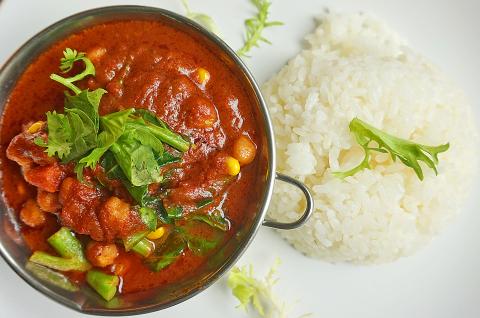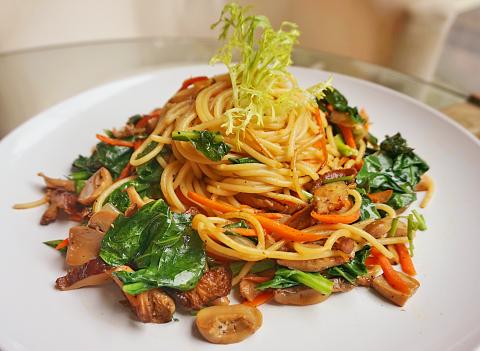“If you can’t tell the difference between a vegan chocolate cake and a normal chocolate cake, just eat vegan ones in the future — they’re supposed to be healthier.” Words of wisdom from my mother.
A few hours earlier, my friend and I had planned to stuff our faces with juicy hamburgers after dining at Mianto (米愛多), a vegan restaurant on Xinsheng South Road (新生南路). I’ve had my share of vegan meals — all for the sake of food writing. But for someone raised on a steady diet of skewered pork and chicken curries, it was all bland and forgettable. Not to mention the pint-sized portions — hence the need for post-meal burger binges. The fact that Mianto was one of the two restaurants in Asia to make it on this year’s Vegans Are Cool outstanding restaurants list did make it more appealing. But the mere mention of chocolate cake made me concede.
Opened by South African expat Michel Cason and interior designer Antonio Chen (陳豐秀) over a year ago, the restaurant is a compact space with floor-to-ceiling glass windows looking out onto Lianyun Park (連雲公園). A bakery area occupies the entrance, where dark wood-paneled walls are covered with black-and-white portraits, evoking the vibe of a lower Manhattan cupcake joint. A raised platform where patrons must take off their shoes leads to the main dining area, which consists of communal tables, and a smaller seating area by the window for parties of two.

Photo: Dana Ter, Taipei Times
With burgers still on our minds, we place our orders — the highly recommended spaghetti al funghi (NT$250), chana ma soul la or chickpea curry (NT$250), a ciabatta plate (NT$150) and, of course, the vegan chocolate cake (NT$65).
I was pleasantly surprised to find that it wasn’t only the desserts that were delectable. The crunchy mix of shiitake mushrooms, spinach and shredded carrots in the spaghetti al funghi, pan-fried with onions, garlic and black pepper, was enough to convince me that it was possible for vegan food to be not just edible, but palatable as well. Smoky and slightly charred on the edges, the shiitake mushrooms — which are sourced from the misty mountains of Fuhsing District (復興) in Taoyuan — are the best component. I was grateful for the peppery kick combined with the natural sweetness of the carrots, both of which provided much flavor and texture to the spaghetti.
The chana ma soul la is a good choice for those who fear eating salads when dining with vegan friends. There’s not too much of a heavy curry taste in the dish. Rather, the assortment of Indian herbs soaked in a mildly spicy tomato-based curry tastes more like a sauce. The chickpeas — probably one of the blandest legumes imaginable — are enlivened by the minty, aromatic curry. Like the spaghetti al funghi, the ingredients in the chana ma soul la are crunchy and fragrant, but not overwhelmingly so. Though the dish is served with a scoop of white rice, I found myself scooping every last drop of the curry as if it were a bowl of rich, creamy soup.

Photo: Dana Ter, Taipei Times
While technically an appetizer, we treated the ciabatta plate as a side dish to nibble on in between main courses. It pairs well with the olive oil, balsamic vinegar and olives, although I preferred to use it to mop up the last drops of curry. The homemade bread is served fresh from the oven with no added sugar or preservatives. The bread is soft and fluffy on the inside with a crust that crumbled delicately.
Finally, the vegan chocolate cake lived up to my expectations — for the most part. While the sponge layers were a little dry, the runny top layer of melted chocolate more than made up for it. There was only a sliver of cream, which I appreciated as I’m not a big fan of over-the-top indulgence.
Chocolate cake aside, it will still take a lot of convincing to convert me to veganism, but Mianto manages to make vegan dining enjoyable and tasty with subtle but memorable flavors.
After we combed up the last crumb, my friend looked up from his empty plate and asked, “Burgers?”
There was no need. We walked away with full, satisfied stomachs.

April 14 to April 20 In March 1947, Sising Katadrepan urged the government to drop the “high mountain people” (高山族) designation for Indigenous Taiwanese and refer to them as “Taiwan people” (台灣族). He considered the term derogatory, arguing that it made them sound like animals. The Taiwan Provincial Government agreed to stop using the term, stating that Indigenous Taiwanese suffered all sorts of discrimination and oppression under the Japanese and were forced to live in the mountains as outsiders to society. Now, under the new regime, they would be seen as equals, thus they should be henceforth

Last week, the the National Immigration Agency (NIA) told the legislature that more than 10,000 naturalized Taiwanese citizens from the People’s Republic of China (PRC) risked having their citizenship revoked if they failed to provide proof that they had renounced their Chinese household registration within the next three months. Renunciation is required under the Act Governing Relations Between the People of the Taiwan Area and the Mainland Area (臺灣地區與大陸地區人民關係條例), as amended in 2004, though it was only a legal requirement after 2000. Prior to that, it had been only an administrative requirement since the Nationality Act (國籍法) was established in

Three big changes have transformed the landscape of Taiwan’s local patronage factions: Increasing Democratic Progressive Party (DPP) involvement, rising new factions and the Chinese Nationalist Party’s (KMT) significantly weakened control. GREEN FACTIONS It is said that “south of the Zhuoshui River (濁水溪), there is no blue-green divide,” meaning that from Yunlin County south there is no difference between KMT and DPP politicians. This is not always true, but there is more than a grain of truth to it. Traditionally, DPP factions are viewed as national entities, with their primary function to secure plum positions in the party and government. This is not unusual

US President Donald Trump’s bid to take back control of the Panama Canal has put his counterpart Jose Raul Mulino in a difficult position and revived fears in the Central American country that US military bases will return. After Trump vowed to reclaim the interoceanic waterway from Chinese influence, US Defense Secretary Pete Hegseth signed an agreement with the Mulino administration last week for the US to deploy troops in areas adjacent to the canal. For more than two decades, after handing over control of the strategically vital waterway to Panama in 1999 and dismantling the bases that protected it, Washington has